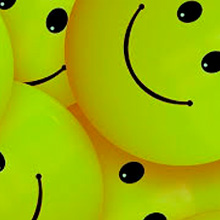
El pasado 6 de octubre fue el Día Mundial de la Sonrisa. Con ese motivo, el boletín mensual de Humor Sapiens publicó un editorial y yo también quería reflexionar sobre esta capacidad que, si no nos diferencia radicalmente a los seres humanos del resto de los animales –ellos también sienten y expresan emociones–, sí lo hace de un modo notable.
La sonrisa es un pasaporte que nos franquea fronteras, una llave que nos abre puertas, más que las palabras “gracias” o “por favor” (que, en cualquier caso, siempre suenan mejor acompañadas de una sonrisa); más aún que “tirar” y “empujar, y me van a permitir el chiste, hablando, como hablamos aquí, de sonrisas. Porque hace solo unos días que leí este chascarrillo en una taza de esas con mensaje, y ciertamente sonreí: “Hay dos palabras que te abrirán muchas puertas: tirar y empujar”.
Si la distancia más corta entre dos puntos es siempre la línea recta, la sonrisa es siempre el trayecto más breve entre dos personas; un esperanto que nos permite comunicarnos con todos, cualquiera que sea su idioma. En el Nuevo Testamento, en concreto en Hch 2, 1-13, se cuenta que en Pentecostés los apóstoles anunciaban a Jesús en su lengua –el arameo–, pero todos los allí presentes los entendían cada uno en su propio idioma, y se preguntaban cómo era posible. En el mismo texto se nos da la respuesta: fue obra del Espíritu Santo. Pero nosotros podríamos corregir a la Biblia y decir que fue porque los apóstoles sonreían, porque predicaban sonriendo. O tal vez no corregirla, sino solo matizarla: el Espíritu Santo se transformó en la sonrisa de aquellos hombres, como antes –en el bautizo de Jesús en el Jordán– se había transformado en una paloma.
Las ventajas de sonreír son muchas y muy grandes, según explican los científicos: mejora la autoestima, ayuda a que los demás confíen más en uno, reduce el nivel de estrés y hace más felices a los que nos rodean, porque es contagioso –no tanto como bostezar, pero casi–.
No hay que confundir la sonrisa con la risa, aunque el Diccionario de la Lengua Española (DLE) afirme que “sonreír” es “reírse un poco o levemente, y sin ruido”, como si la sonrisa fuese una risa pequeña y silenciosa, con sordina, y se pudiera establecer una gradación entre la carcajada, la risa y la sonrisa, de modo que esta última fuese la hermana pequeña de las otras dos. Como nos advierte Celestino Fernández de la Vega, el filósofo gallego, en O segredo do humor (El secreto del humor), editado por primera vez hace ya sesenta años, y luego ha insistido su discípulo el caricaturista y escritor Siro López Lorenzo en muchas de sus publicaciones, la risa es un límite externo de la sonrisa, igual que la comicidad es un límite externo del humorismo. La risa es la respuesta apropiada a lo cómico; en cambio, el humorismo es mala conciencia de la risa, risa reprimida o forzada, esfuerzo por no reír o reír por no llorar; por eso la respuesta adecuada al humorismo no es la risa, sino la sonrisa, que es tan distinta de la risa como el humorismo de la comicidad. La comicidad se dirige a la inteligencia pura y procura solo la risa, la diversión del espectador. La sátira busca lo mismo, pero no como un fin en sí mismo, sino para ridiculizar o humillar a su adversario: usa la risa contra algo o alguien. El humorismo, por el contrario, se dirige tanto a la inteligencia como al sentimiento, con un doble fin: superar la adversidad con la sonrisa comprensiva (y estaremos entonces ante un humorismo benévolo) o evitar la desesperación con la sonrisa ácida, con la burla de las propias flaquezas y circunstancias adversas (y nos encontraremos en ese caso ante un humorismo sarcástico).
La sonrisa es el mejor de los pasaportes –decía–, el mejor de los idiomas universales. Hablo, claro, de la sonrisa sincera, franca, genuina, auténtica, natural. De la sonrisa bondadosa, cómplice, incluso tímida. No, por supuesto, de la sonrisa falsa, fingida, artificial, forzada, sardónica. Muchos menos de la sonrisa arrogante, altanera, maliciosa, cínica; de la sonrisa del tirano, del torturador o simplemente del político; de cualquier político –piense cada quien en los que tiene más cerca–. No hay ninguno que no sonría, pero tampoco que no lo haga fingidamente –a pesar de sus asesores de imagen (o son malos los profesores o lo son los alumnos)–, y no solo en campaña electoral, sino permanentemente (tal vez porque están en campaña electoral perpetua).
La sonrisa sincera es siempre bella. Pocas cosas –tal vez ninguna– puede haber en el mundo más hermosas que una sonrisa franca: la sonrisa de un bebé, de una madre, de una novia, de un amigo, de un abuelo… El arte –que imita a la naturaleza cuando no es esta la que le imita a él– lo sabe y lo ha dejado patente sobre todo en La Gioconda de Leonardo da Vinci, una sonrisa que cinco siglos después de ser pintada –lo fue a principios del XVI– sigue siendo todo un enigma. Yo creo que el misterio de la sonrisa de La Monna Lisa –como también es llamado el cuadro– tiene que ver con que la retratada sonríe más con los ojos que con la boca. Que no sonreímos únicamente con los labios, sino con todo el rostro, y particularmente con los ojos, es algo sabido desde siempre, pero muchos lo redescubrimos con la pandemia del covid: la mascarilla –al taparnos la boca– nos obligó a sonreír más con los ojos. No estuvimos dos años sin sonreír, a pesar de que había motivos para no hacerlo –o para hacerlo más que nunca, según se mire (el que sonríe, como el que canta, su mal espanta)–, sino sonriendo con los ojos, incluso –los que no sabían– aprendiendo a hacerlo. Fue un ejercicio admirable.
Pero la de La Gioconda no es la única gran sonrisa de la historia del arte. Estoy pensando especialmente en otra que me toca muy de cerca, geográficamente hablando: la sonrisa del profeta Daniel en el Pórtico de la Gloria de la Catedral de Santiago de Compostela, en Galicia (España). Si la sonrisa de la Gioconda tiene quinientos años de antigüedad, la del profeta Daniel ha cumplido ya los ochocientos cincuenta. No en vano, el Pórtico de la Gloria, realizado en el siglo XII por el maestro Mateo y sus trabajadores, constituye una de las joyas del románico universal. La sonrisa de Daniel es tan enigmática como la de la Monna Lisa. ¿De qué se ríe? ¿Por qué se ríe? En las iglesias medievales hay muchas tallas que expresan humorismo y comicidad picarescos, pero no son efigies de profetas y se encuentran en lugares marginales (gárgolas, cabos de vigas) y no en sitios céntricos como el arco central del Pórtico de la Gloria, según explica el hispanista británico John Rutherford, enamorado muy particularmente de Galicia –y de una gallega, con la que se casó– y académico honorario en la Real Academia Galega (RAG) desde 2008, cuando ingresó con un discurso titulado O fermoso sorriso de Daniel (La hermosa sonrisa .
La versión popular quiere que la sonrisa de Daniel venga provocada por la figura femenina de exuberantes pechos colocada en la contrafachada y atribuida a doña Urraca, Esther, Santa Águeda o la reina de Saba. Incluso se dice que los senos fueron rebajados en el franquismo. Pero la interpretación que más le gusta y convence a Rutherford es una bienvenida acogedora y confortadora para los peregrinos.
En fin, que sonreír es tan bueno y tan importante que se ha ganado siempre la atención del arte, y no solo del arte. Son muchas, por ejemplo, las clínicas odontológicas que se publicitan con el lema “diseñamos sonrisas”. Claro que las sonrisas de las consultas del dentista son en realidad lo que en España llamamos “sonrisas Profidén” –por una conocida marca de dentífrico–; es decir, sonrisas fingidas, forzadas, artificiales. De político, vaya.



Oh, humor, oh, humor | The smile
By Félix Caballero
It was my investigations of the presence of humor in the work of various plastic artists: sculptors, photographers, painters, draftsmen, that have motivated me to write the section on “Visual Humors”, which is part of the content of the Humorsapiens Bulletin, a monthly magazine, which has become required reading for creators, researchers, essayists and readers interested in graphic humor.
As a creator too, I am interested in humorous photography, for its capacity for observation and sparkling joy, capturing peculiar, curious, absurd moments of contemporary street life, with emotional and ironic images of everyday urban events.
This photographic hobby has recently given me great satisfaction, when I agreed with Pepe Pelayo, creator with his son Alex of humorsapiens.com, to edit the book “Photo & Grafía” Image and word in search of humor, (it can be purchased on Amazon) where for forty photos of me, Pelayo has written a humorous text, whether in the form of an article, monologue, letter, sketch, etc., to form a perfect “pairing”, in an original volume, that provokes laughter of the readers.
I practiced my status as a humorous photographer in Cuba, and later, over the years, I developed it in the Galician city of A Coruña, where I currently reside. It is very exciting to go out on a “photographic hunt”, wherever we find ourselves, with our eyes alert and our sense of humor awake.
On this tenth anniversary of humorsapiens.com, the page that represents us for all its contents, I want to remember the first photos that I captured, in my new location, twenty years ago, and that are unknown to readers. Seeing them again has confirmed the importance of humor and its benefits for the mind and body, and I hope you enjoy them too.
Thank you, humorsapiens.com for this wonderful opportunity! May you have many more years!
Last October 6 was World Smile Day. For this reason, the monthly Humor Sapiens newsletter published an editorial and I also wanted to reflect on this capacity that, if it does not radically differentiate us human beings from the rest of the animals - they also feel and express emotions -, it does do so a remarkable way.
The smile is a passport that crosses borders, a key that opens doors for us, more than the words “thank you” or “please” (which, in any case, always sound better accompanied by a smile); even more so than “pulling” and “pushing,” and you'll allow me the joke, speaking, as we speak here, of smiles. Because just a few days ago I read this joke on one of those mugs with a message, and I certainly smiled: “There are two words that will open many doors for you: pull and push.”
If the shortest distance between two points is always a straight line, the smile is always the shortest distance between two people; an Esperanto that allows us to communicate with everyone, whatever their language. In the New Testament, specifically in Acts 2, 1-13, it is said that at Pentecost the apostles announced Jesus in their language – Aramaic – but everyone present understood them, each in their own language, and they wondered how was it possible. In the same text we are given the answer: it was the work of the Holy Spirit. But we could correct the Bible and say that it was because the apostles smiled, because they preached smiling. Or perhaps not correct it, but only qualify it: the Holy Spirit transformed into the smile of those men, as before – at the baptism of Jesus in the Jordan – he had transformed into a dove.
The advantages of smiling are many and very great, as scientists explain: it improves self-esteem, helps others trust you more, reduces the level of stress and makes those around us happier, because it is contagious – not so much like yawning, but almost.
A smile should not be confused with laughter, although the Dictionary of the Spanish Language (DLE) states that “smile” is “to laugh a little or lightly, and without noise,” as if the smile were a small, silent laugh, with muted, and a gradation could be established between laughter, laughter and smile, so that the latter would be the little sister of the other two. As Celestino Fernández de la Vega, the Galician philosopher, warns us in O segredo do humor (The secret of humor), published for the first time sixty years ago, and then his disciple, the caricaturist and writer Siro López Lorenzo, has insisted on many of In his publications, laughter is an external limit of the smile, just as comedy is an external limit of humor. Laughter is the appropriate response to the comic; On the other hand, humor is a poor awareness of laughter, repressed or forced laughter, an effort not to laugh or laughing to avoid crying; That is why the appropriate response to humor is not laughter, but a smile, which is as different from laughter as humor is from comedy. Comedy is aimed at pure intelligence and seeks only laughter and amusement for the viewer. Satire seeks the same thing, but not as an end in itself, but to ridicule or humiliate its adversary: it uses laughter against something or someone. Humor, on the contrary, is directed at both intelligence and feeling, with a double purpose: to overcome adversity with a sympathetic smile (and we will then be faced with a benevolent humor) or to avoid despair with an acidic smile, with mockery. of one's own weaknesses and adverse circumstances (and in that case we will find ourselves faced with sarcastic humor).
The smile is the best of passports, he said, the best of universal languages. I am talking, of course, about the sincere, frank, genuine, authentic, natural smile. Of the kind, knowing, even shy smile. Not, of course, the false, feigned, artificial, forced, sardonic smile. Much less of the arrogant, haughty, malicious, cynical smile; of the smile of the tyrant, the torturer or simply the politician; of any politician – let everyone think about those closest to them. There is no one who does not smile, but neither does one who does not do so feignedly –despite their image consultants (either the teachers are bad or the students are bad)–, and not only in the electoral campaign, but permanently (perhaps because they are in perpetual electoral campaign).
The sincere smile is always beautiful. There can be few things – perhaps none – in the world more beautiful than a sincere smile: the smile of a baby, a mother, a girlfriend, a friend, a grandfather... Art – which imitates nature when This is not the one that imitates him – he knows it and has made it evident especially in Leonardo da Vinci's La Mona Lisa, a smile that five centuries after it was painted – it was at the beginning of the 16th century – remains an enigma. I believe that the mystery of the smile of La Monna Lisa – as the painting is also called – has to do with the fact that the sitter smiles more with her eyes than with her mouth. That we do not smile only with our lips, but with our entire face, and particularly with our eyes, has always been known, but many of us rediscovered it with the covid pandemic: the mask – by covering our mouth – forced us to smile more with the eyes. We did not go two years without smiling, even though there were reasons not to do so – or to do so more than ever, depending on how you look at it (he who smiles, like he who sings, his evil scares away) – but smiling with our eyes, even –those who didn't know– learning to do it. It was an admirable exercise.
But La Gioconda's is not the only great smile in the history of art. I am thinking especially of another that touches me very closely, geographically speaking: the smile of the prophet Daniel in the Portico of Glory of the Cathedral of Santiago de Compostela, in Galicia (Spain). If the Mona Lisa's smile is five hundred years old, that of the prophet Daniel is already eight hundred and fifty years old. Not in vain, the Portico of Glory, made in the 12th century by Master Mateo and his workers, constitutes one of the jewels of universal Romanesque art. Daniel's smile is as enigmatic as that of the Monna Lisa. What are you laughing at? Why are you laughing? In medieval churches there are many carvings that express picaresque humor and comedy, but they are not effigies of prophets and are found in marginal places (gargoyles, ends of beams) and not in central places such as the central arch of the Portico of Glory, as explained the British Hispanist John Rutherford, particularly in love with Galicia – and with a Galician woman, whom he married – and honorary academic at the Royal Galician Academy (RAG) since 2008, when he entered with a speech titled O fermoso sorriso de Daniel (The Daniel's beautiful smile).
The popular version wants Daniel's smile to be caused by the female figure with exuberant breasts placed on the counterfaçade and attributed to Doña Urraca, Esther, Saint Agatha or the Queen of Sheba. It is even said that breasts were reduced during the Franco era. But the interpretation that Rutherford likes and convinces most is a welcoming and comforting welcome for the pilgrims.
In short, smiling is so good and so important that it has always earned the attention of art, and not just art. There are many, for example, dental clinics that advertise with the slogan “we design smiles.” Of course, the smiles at the dentist's offices are actually what we call in Spain “Profiden smiles” –after a well-known brand of toothpaste–; that is, fake, forced, artificial smiles. As a politician, wow.
(This text was converted to English through Google Translate)
